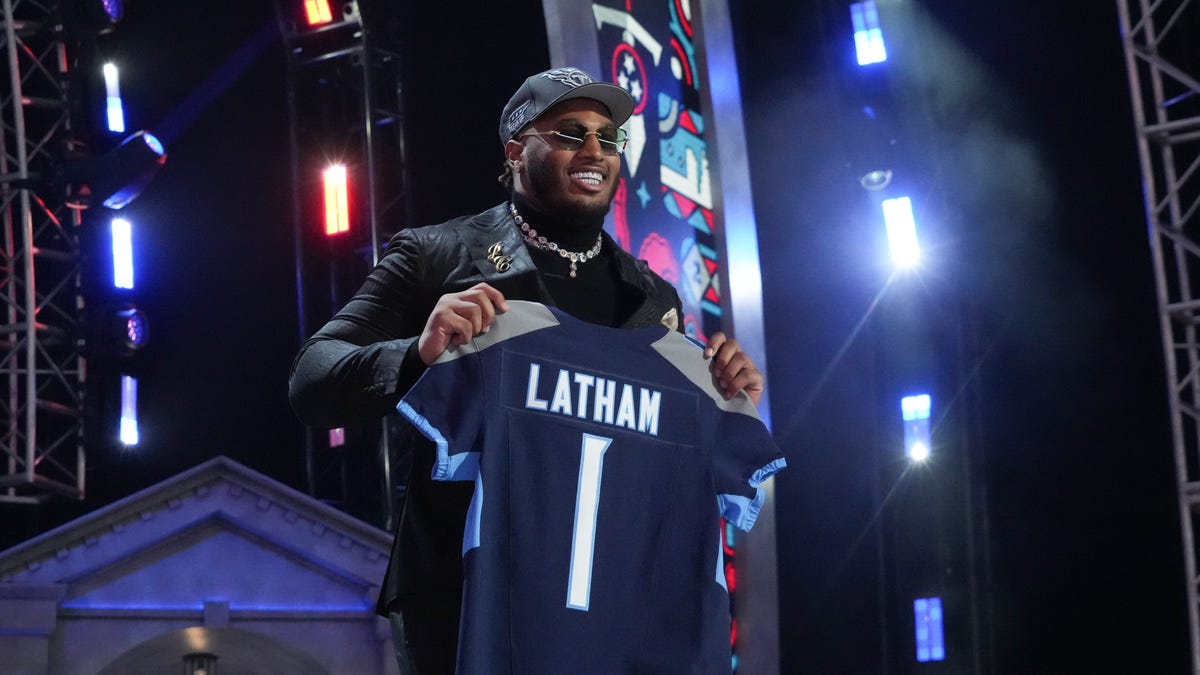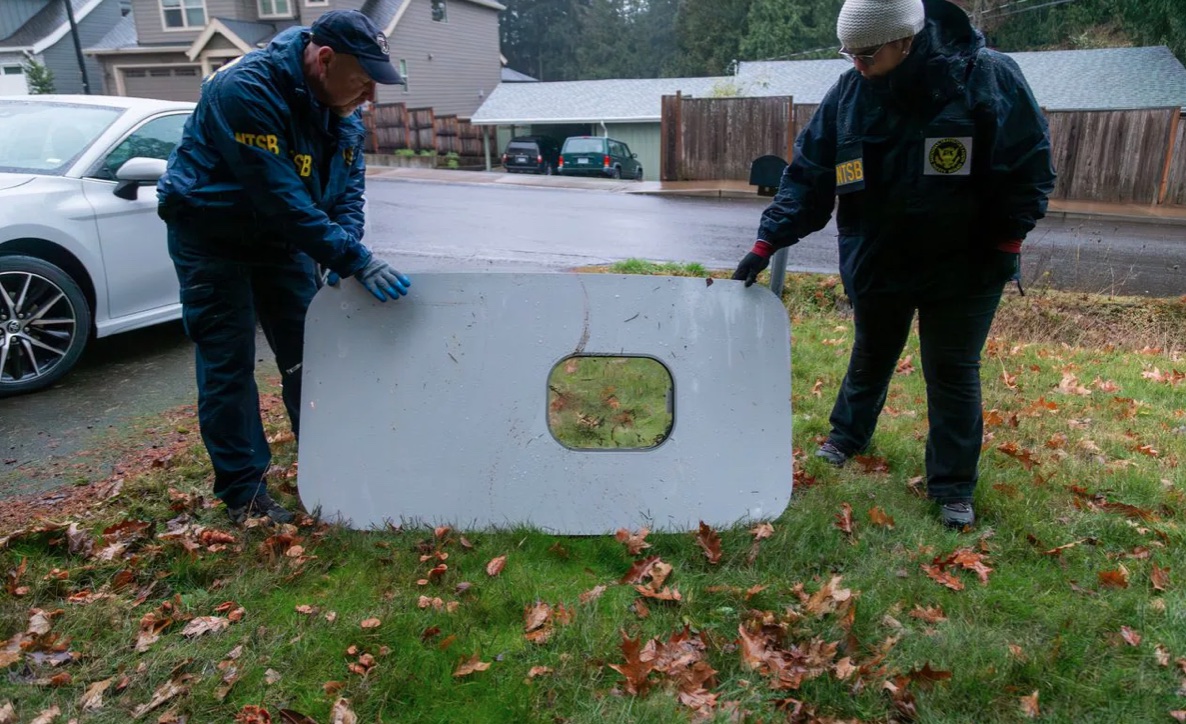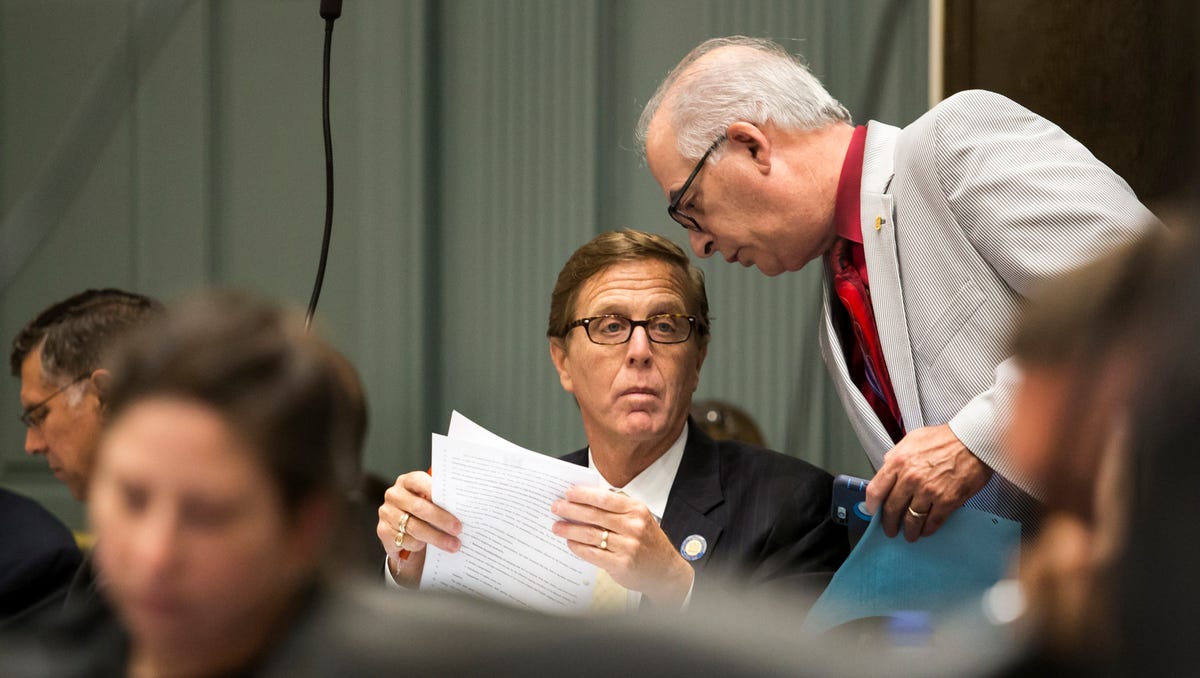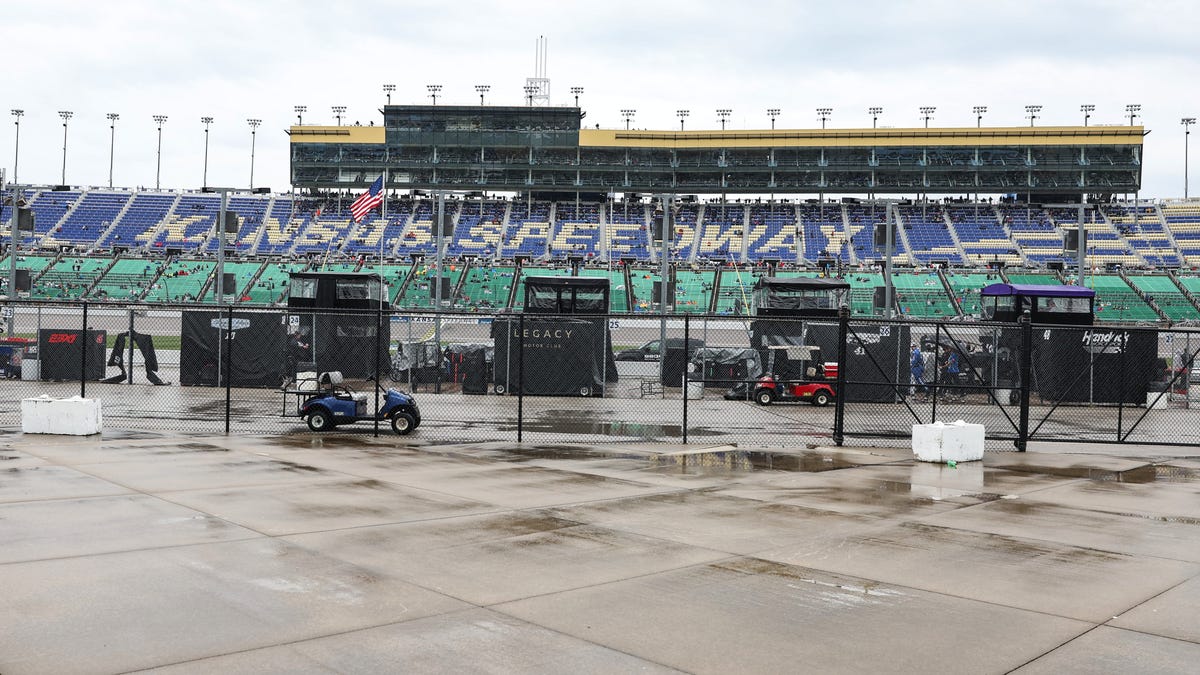Arizona
Oakland star Trey Townsend has decided where he’ll play his final season

The Trey Townsend mystery tour has reached its final destintation.
Townsend, who starred for Oakland for four years and recently helped lead the Golden Grizzlies to the best season in program history, will finish his college career at the University of Arizona. Townsend and Oakland head coach Greg Kampe both confirmed Townsend’s next stop to The News on Wednesday.
Townsend, 21, had made multiple official visits as one of the hottest transfer targets on the market, including to Arizona and Ohio State. His final choice came down to those two schools.
Townsend also made an unofficial visit to Michigan, to meet with new head coach Dusty May, and he spoke on the phone with Michigan State head coach Tom Izzo, but he canceled his visit to East Lansing this week. Michigan State was interested in both Townsend and fellow forward Frankie Fidler from the University of Omaha; Fidler committed to Michigan State on Tuesday, a day after Townsend’s visit to MSU was canceled.
Townsend had significant interest from at least a dozen other schools at the power-conference level.
At Arizona, Townsend will help fill the void left by forward Keshad Johnson, who averaged 11.5 points and 5.9 rebounds as a senior. Johnson is expected to be a second-round pick in the NBA Draft.
Townsend, 6-foot-6 and 225 pounds, is coming off a stellar fourth season at Oakland, averaging 17.3 points and 8.1 rebounds in being named the Horizon League player of the year. He also was named MVP of the Horizon League tournament, after scoring 38 in a championship-game victory over Milwaukee to earn the Golden Grizzlies their first trip to the NCAA Tournament since 2011. In the NCAA Tournament, Townsend posted double-doubles in a win over Kentucky and an overtime loss over N.C. State, to draw significant interest in the transfer market.
Townsend is an Oxford native whose parents, Skip and Nicole Leigh, both played basketball at Oakland. Since the age of 8, Townsend wanted to play for Kampe, and he did for four years. He earned his degree, and his No. 4 someday will hang from the rafters at the O’Rena.
After this season ended, Townsend declared for the NBA Draft and hired an agent, to test the process, but he always was expected to play a fifth collegiate season and take advantage of his Name, Image and Likeness opportunities. Townsend, who averaged 16.5 points as a junior and 13.3 points as a sophomore, was expected to get an NIL deal worth well into the six figures by transferring to a power conference.
Arizona, coached by Tommy Lloyd, will play in the Big 12 Conference next season. The Wildcats are coming off an appearance in the Sweet 16, falling to Clemson as a No. 2 seed.
Townsend, who was named the Lou Henson Award winner as the top mid-major player in college basketball, is one of several big roster losses for Oakland this offseason, along with Blake Lampman, Jack Gohlke and Rocket Watts, who have graduated and have exhausted their college eligibility.
tpaul@detroitnews.com
@tonypaul1984

Arizona
Arizona baseball shakes off poor start to finish sweep of Stanford

Having clinched another Pac-12 series on Saturday night, as well as a berth in the conference tournament, a day game finale had all the makings for a potential letdown. And early on it looked that way for Arizona.
Bad at-bats at the plate were compounded by multiple mental errors in the field, most in one inning as Stanford took a 2-0 lead in the top of the 2nd inning. That prompted Chip Hale to make a mound visit, something he normally only does when changing pitchers.
“It wasn’t very friendly,” Hale said when asked the gist of his conversation with his infield. “I was just upset. We do a lot of things to get you ready for the game and it just looked like guys weren’t ready.”
But despite that shaky start, Arizona got itself composed and ended up finishing off another series sweep.
A 6-run bottom of the 6th, combined with solid pitching from Cam Walty and two relievers, gave the Wildcats a 7-2 win over Stanford on Sunday afternoon at Hi Corbett. It was their fifth series sweep of the season, fourth in Pac-12 play, and maintained its 2-game lead on Utah heading into next weekend’s trip to Salt Lake City.
Arizona (29-17, 17-7) won its 10th straight conference home game despite managing only a run on three hits over the first five innings against Cardinal starter Gavin Dugan. The tide turned in the 6th when Mason White lead off with a single, stole second and went to third after Garen Caulfield reached on a throwing error.
Stanford pulled Dugan, bringing in a reliever in Joey Volchko who threw six shutout innings on Tuesday. Emilio Corona greeted him with a single to center to tie the game at 2.
It was Corona’s 15th hit during an 8-game hit streak that’s also included six walks. He walked only seven times in his first 39 games this season.
“I’m really just trusting what I’ve been working on and just kind of cleaning up some mechanical things, just trying to stay inside the ball and really just taking what the game gives me,” said Corona, who has his average back up to .280 after being as low as .214 in late March. “If it’s a walk one at-bat take your walks, if it’s a base hit take the hit. Just swinging at the right pitches, for sure.”
After a sac bunt and a pop out, freshman Andrew Cain gave Arizona the lead when he crushed a 97 mph fastball to left-center for a 2-run double. Three more Wildcats would reach after that, capped by Brendan Summerhill’s bases-clearing double to make it 7-2.
That ended a 2-for-28 skid for Summerhill, whom Hale says actually makes too much contact sometimes because he puts pitchers’ pitches into play.
“If he’d swing and miss sometimes early in the count …,” Hale said.
Walty got his conference-leading 7th win by going seven strong, allowing nine hits and walking one. The two runs he gave up were hardly his fault, either.
Stanford’s Malcolm Moore led off the 2nd with a gift double after Corona didn’t see the ball off the bat and it fell innocently between him and Summerhill in right center. And with the Wildcats employing a 4-man outfield, no one rotated to cover second base for Corona’s throw in as Moore got the extra base.
A 1-out single against the shift scored Moore, then a grounder to first should have ended the inning but when Tommy Splaine turned to throw to second he did so to the wrong infielder and no outs were recorded. A single through the right side followed, making it 2-0.
Walty would allow at least one baserunner every inning after that, including loading the bases with two out in the 7th, but each time worked himself out of his own mess.
“Walty kept us in it with really, really good pitching, kind of let the guys settle down and then they got it going,” Hale said.
Casey Hintz and Tonko Susac followed with perfect 8th and 9th innings, with Susac recording a ninth consecutive scoreless frame since getting moved to the bullpen. He’s allowed seven baserunners and struck out 16 in that span.
Arizona has its second-best record in school history after 24 conference games but is no guarantee to win the Pac-12 title. The Wildcats face their two closest challengers the final two weekends, first at Utah (30-15, 15-9) and then the regular-season finale May 16-18 at Hi Corbett against Oregon State (35-12, 14-9).
Before that, though, is one last nonconference game Tuesday at ASU. The Sun Devils took two of three in Tucson in March.
“We want to score 100 and give up zero,” Summerhill said. “We want to beat them, they will they beat us here this year. So we’re gonna go up there and play our butts off and beat them as bad as we can.”
Arizona
TSMC factory construction is displacing native Arizona plants. This company saves them

Maria Hollenhorst/Marketplace
“What we have been able to do with developers is make them understand that not only is there an environmental advantage to saving the trees … there’s also a monetary advantage,” says Rob Kater, owner of Native Resources.
This story originally aired on “Marketplace” on May 1.
One of the flagship projects in the U.S. government’s effort to rebuild the domestic supply chain for semiconductors lies 25 miles north of downtown Phoenix, on what was, until recently, undeveloped desert.
The Taiwan Semiconductor Manufacturing Co., or TSMC, first announced plans to build a chips factory in north Phoenix in May 2022 at a cost of $12 billion. In the years since the CHIPS and Science Act passed, TSMC has increased that planned investment to more than $65 billion and three factories.
But before construction began on TSMC’s 1,100 acres of desert land, the company had to deal with something else: the native plants that were there first.
“TSMC came here about three years ago, and we had daily calls to Taiwan to explain our system,” said Rob Kater, owner of Native Resources International, a plant relocation, nursery and landscape company. “It was difficult for [TSMC] to wrap their heads around why we have to save the trees.”
The Phoenix metropolitan area lies within the Sonoran Desert, which, according to the National Park Service, has more than 2,000 native plant species, including saguaro cactuses. Saguaros can live up to 200 years and are so synonymous with this area, they’re pictured on Arizona license plates.
In 1981, the city of Scottsdale passed an ordinance barring people from removing certain plants, including saguaros, without a permit. Phoenix and other surrounding cities followed suit, passing ordinances requiring developers to salvage native species and, in some cases, replant them back into the landscape.

Maria Hollenhorst/Marketplace
The inventory on Native Resources’ 8-acre grounds include pipe organ cactuses, the tallest above, and three smaller cactuses from the senita family, which are not native to the Sonoran Desert. | Photo credit: Maria Hollenhorst
Within those local laws, Rob Kater found a niche at the intersection of conservation and development.
“We’re able to monetize the whole program of saving native materials,” he said. Native Resources helps developers inventory plants on their land, identify which need to be preserved, and then salvage, store and replant them back into the landscape once construction is finished.
Kater said the company’s largest customer is a big housing development in an area northwest of Phoenix called Vistancia.
“In the Vistancia area, we’ll be doing about [3,000] to 4,000 trees and cacti,” he said. TSMC, recipient of $6.6 billion of federal funding through the CHIPS Act, was a smaller project — about 1,000 trees.
“What we have been able to do with developers is make them understand that not only is there an environmental advantage to saving the trees … there’s also a monetary advantage,” Kater said. “We look at each and every tree as being a living statue.”
Kater said you can’t buy some of these trees in nurseries because they grow too slowly.
Native Resources pulls in $10 million in annual revenue, Kater said.
On Native Resource’s 8-acre lot in north Phoenix, Kater showed Marketplace’s Kai Ryssdal and The Washington Post’s Heather Long some of his inventory.

Maria Hollenhorst/Marketplace
Kater sells these young saguaro “spears” for about $35-$40 a foot. It can take 100 years or more for saguaros to grow an arm, he said.
“That tree is called an ironwood tree, it’s about 5 feet in diameter, and it [costs] about $8,000,” he said.
But with Phoenix’s rapid population growth, the value of land underneath those trees is going up.
“[This is] an area that 20 years ago was just a cotton farm, but now has been just fully developed,” Kater said.
Across the street from Native Resources, with its rows of ironwood trees and a small army of saguaro cactus spears, there is a Goodwill and a pet care center. Five minutes down the road, there is a big shopping center and a movie theater.
Would Kater consider selling some of his land?
“It is tempting,” he said. “We have actually lost three of our largest nurseries to development because of the numbers that were put in front of them. And that caused an incredible change in our market and our supply when these nurseries that we were all dependent upon turned over and sold to large-scale development.”
Phoenix has gained almost 200,000 new residents since 2020. Kater’s business is facilitating one small part of that change, but with the increased investment in semiconductor factories, more is coming.
“I think the idea is, if change is coming, we need to understand it and get society ready for it,” he said.
In future installments of our series “Breaking Ground,” Marketplace will also explore the implications of that change on workforce development, culture and the housing market.
Maria Hollenhorst/Marketplace Native Resources stores and transports trees and cactuses in large wooden boxes. Above, an ironwood, right, rests on the flatbed along with foothill palo verdes, the Arizona state tree.

Maria Hollenhorst/Marketplace
Kater points to some of his inventory, including the ironwood trees in front.
More stories from KJZZ
Arizona
Clark Candiotti tosses 5-hit shutout over Stanford, extending Arizona’s Pac-12 lead

As Chip Hale inquired with the home plate umpire about challenging an out call at first base that ended the bottom of the 8th inning, Clark Candiotti didn’t wait to see if a review would happen or not. Nor did he check with pitching coach Kevin Vance about how short his leash might be.
He was on the mound within seconds of that play at first, getting ready to throw his final set of warmup pitches for what would be his second complete game of the season.
“I didn’t hear anything,” Candiotti said. “I just went out there and treated it like the first inning.”
The senior right-hander limited Stanford to five singles in a 5-0 win on Saturday night at Hi Corbett Field. Two of those hits came in the top of the 9th, but after Arizona had scored two insurance runs in the bottom of the 8th Candiotti was allowed to match his career high with 119 pitches.
“His last hitter was the pop-up before the last hitter, but then when he got to two outs we gave him one more hitter,” said UA coach Chip Hale, who recorded his 100th win at his alma mater.
Candiotti (5-2) struck out seven and got nine ground ball outs, both of which were the result of his gameplan.
“I think it’s just a matter of getting ahead of hitters and just attacking, try to get them out in four pitches or less and let the defense do their work,” he said.
Of Stanford’s 31 plate appearances, 20 started 0-1 or the ball was put in play, and 17 of the batters Candiotti retired saw four or fewer pitches. He’s the first UA pitcher with multiple complete games in a season since Garrett Irvin in 2021, and the first two do so twice in Pac-12 play since Cameron Ming in 2017.
“Clark controlled the game,” Hale said. “Obviously he was missing barrels.”
Arizona (28-17, 16-7 Pac-12) had allowed 40 runs in the previous three games yet its ERA in the league is 3.45. The Wildcats have multiple shutouts in conference play for the first time since 2016, and combined with losses by Oregon State and Utah (twice) on Saturday have a 2-game lead in the loss column on those teams and Oregon with seven remaining.
As impressive as Candiotti was, Arizona’s approach at the plate was also on point. Despite facing a lefty, which has been the team’s nemesis this season, the Wildcats made Stanford freshman Christian Lim throw 110 pitches in five innings after Friday starter Matt Scott didn’t get out of the 5th.
“I think we’ve just had a really good gameplan coming in,” said Garen Caulfield, who was 3 for 5 and was a home run short of the cycle.
Caulfield has batted third the last two games, moving behind Mason White. Hale said the move was partly due to the absence of Adonys Guzman, who had been batting cleanup but missed a second straight game—he’s expected to start Sunday’s finale—after taking a ball off the arm in practice.
The move could become permanent if Caulfield continues to produce. He is 5 for 9 with three RBI and five runs scored in the No. 3 hole.
“We know Garen’s a guy in this league that’s got a reputation, so if you don’t throw strikes to Mason you’re going to have to face Garen with guys on base,” Hale said.
Arizona scored twice in the bottom of the 1st and added another in the 3rd but then went cold in the middle innings before manufacturing offense in the 8th for the second night in a row. On Friday it was a safety squeeze bunt to create a 4-run lead, this time it a sac bunt, a passed ball and a sacrifice fly all contributed to adding two runs.
“It depends on where we are in the order, who we have on the bases, who we have at the plate,” Hale said. “When we get the personnel in the right spots we can do a bunch of things.”
Arizona can go for its fifth sweep in the last six weekends Sunday at 12 p.m. PT, with righty Cam Walty (6-1, 2.64) on the mound.
-

 Politics1 week ago
Politics1 week agoGOP lawmakers demand major donors pull funding from Columbia over 'antisemitic incidents'
-

 World1 week ago
World1 week agoHamas ‘serious’ about captives’ release but not without Gaza ceasefire
-

 Tennessee1 week ago
Tennessee1 week agoHow to buy JC Latham’s Tennessee Titans jersey after 2024 NFL Draft selection
-

 News1 week ago
News1 week agoBoth sides prepare as Florida's six-week abortion ban is set to take effect Wednesday
-

 Politics1 week ago
Politics1 week agoColumbia University’s policy-making senate votes for resolution calling to investigate school’s leadership
-

 Michigan1 week ago
Michigan1 week agoMichigan State football adds DT Brandon Lane from Stephen F. Austin
-

 Politics7 days ago
Politics7 days agoHouse Republicans brace for spring legislative sprint with one less GOP vote
-

 World7 days ago
World7 days agoAt least four dead in US after dozens of tornadoes rip through Oklahoma



















